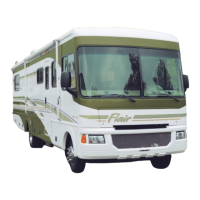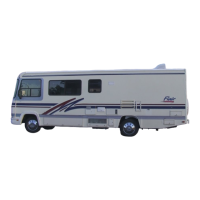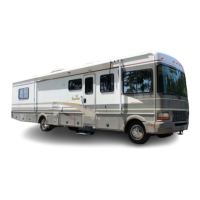Electrical
Systems
from either the chassis or the house batteries.
Activating the relay(s) will prevent battery dis-
charge which may occur over extended storage
periods. During normal use
of
your motor home
the relays must always be in the
"on" position.
If
you plan to store the motor home for an
extended period, press the disconnect switch/es
to
OFF. Remember to press the switch/es to
ON
when you take the motor home out
of
storage.
.1'1
NOTE
J
The
main and auxiliary battery disconnects are auto-
matically engaged anytime the ignition switch
is
turned
on.
.1'1
NOTE
J
A trouble shooting guide and function manual that
explains this system
is
included with your motor home
Owner's Information Package.
.1'1
NOTE
1
When
charging the batteries, the battery disconnect
switches must be
ON.
Battery Inspection
and
Care
A WARNING
Do
not use the motor home when the chassis battery
is
disconnected. The power step will not operate
as
designed
if
the chassis battery
is
disconnected.
If
the
step
is
not
in
the correct extended position, you may
be injured if
you
step out of the motor home.
Check the external condition
of
the battery peri-
odically. Look for cracks in the cover and case.
Check the vent plugs and replace
any
that are
cracked or broken. Keep the battery clean. Acid
film and dirt on the battery top may permit
current to flow between the terminals
and
dis-
charge the battery.
To
clean the hattery:
1.
Be
sure the vent caps are installed and tight.
2.
Wash the battery with a diluted solution
of
baking soda and water to neutralize any
acid present.
08-2
3. Flush with clean water. Foaming around
terminals or
on
top
of
the battery is normal
acid neutralization. Avoid getting the soda
solution in the battery.
4.
Dry the cables and terminals.
5.
Do
not use grease on the bare metal inside
the cable terminals to prevent corrosion.
Grease is an insulator. Electricity will not
flow through it. A plastic battery terminal
spray will protect the terminals after you
have cleaned and reinstalled them .
6.
Check the battery, including water level, at
least once a week. Keep the carrier and
hold down hardware clean and free
of
cor-
rosion and chemical accumulation.
A WARNING
Disconnect the 120-volt shore cord
and
the negative
terminal from the battery/ies before working
on
either
electrical system.
If
you
work
on
the electrical sys·
tems with the power cord connected, you may
be
shocked, electrocuted, or severely burned.
Battery Charging
Both sets
of
batteries will be kept charged
by
the chassis engine alternator and charging sys-
tem while you are driving. The
DC
power con-
verter will charge the chassis and house batteries
when plugged into 120-volt AC service or by
the generator (if equipped).
If
the battery needs
to be charged from a different charging source,
please follow these safety guidelines:
• Leaving a charger connected to a battery for
an extended period
of
time can shorten bat-
tery life.
• Do not smoke near batteries being charged
or which have been recently charged.
Please
note that batteries are being charged
while
you drive, and while you are connected to
120-volt AC power through the converter/
charger circuit.
• Do not break live circuits at the terminals
of
the
battery. Use care when connecting or
disconnecting booster leads or cables.
Attaching booster cables, and poor connec-
tions are a common cause
of
electrical arcs
which can cause explosion.

